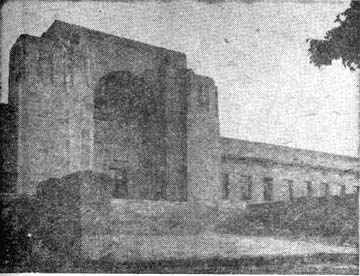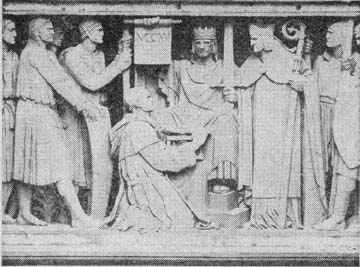
No. 37--Front Entrance, Capitol

No. 37--Front Entrance, Capitol
The inspiration for the capitol as a whole was Bertram Goodhue's. He first ran an architect's pencil around its noble contours, in a moment of exaltation flinging its tower toward to stars. But death drew the pencil from his hand while many markings were yet to be made.It is said that for no other building since the middle ages has such a definite, complete and comprehensive symoblic (sic) scheme been worked out--giving complete unity to the finished edifice. To Mr. Goodhue's immediate associates, of course, goes a great deal of the credit for the capitol. William Younkin has been the supervising architect. Among others who had a large part in the perfecting of the building are Lee Lawrie, the sculptor, Hildreth Meiere, responsible for its mosaics, and Hartley Burr Alexander, who planned the sculpture, wrote the inscriptions and worked out the art symbolism.
The late Dr. Alexander, native of Lincoln and professor of philosophy at the University of Nebraska until he went to Scripps college in 1927, was familiar to two generations of students in Lincoln. A mild retiring person with a furiously intellectual brow, he possessed great ability in the field of poetry and philosophy, writing perhaps twenty books on these subjects. The inscriptions of the building read unhurriedly along its vast corridors, beginning with the hymn of the Navajo, imprinted on the buffalo at the north entrance: "In Beauty I walk. With Beauty before me I walk. With Beauty behind me I walk, with Beauty above and about me I walk."

No. 38--(Capitol Panel.) Signing the Magna Carta
The capitol is the story, in marble, of mankind. Its physical outlines suggest this sprawling inarticulate humanity drawn up finally into strength and beauty. To amplify the story in words would mean great book piled on great book. For every mosaic, every panel and every rising pillar holds the tale of some great struggle or advance in the life of man. At last the story is brought down to Nebraska--its pioneers, its buffalo, its Indians, its corn and wheat. But before Nebraska comes the whole great panorama of mankind. The upward struggle toward a high ethical code, toward religion. is pictured in great movements or incidents of history.The western group of nine panels seen from the promenade describes the development of law in the ancient world: Moses bringing the law to Mount Sinai; Deborah judging Israel; judgment of Solomon; Solon giving a new constitution to the Athenians; publishing of the law of the twelve tables in Rome; establishment of the tribunate of the people; Plato writing his dialog on the ideal republic Orestes before the Areopagites; codification of Roman law under Justinian. On the south wall of the promenade are panels showing the magna carta, signing of the declaration of Independence and writing of the constitution. The eastern group describes development of law in the modern and western world, panels including codification of Anglo-Saxon law, Milton defending free speech, signing of the Pilgrim compact, Lincoln's emancipation proclamation, the Kansas-Nebraska bill and admission of Nebraska as a state.
At the upper corners of the tower eight sculptured figures represent spiritual leaders of civilization, including the prophet Ezekiel, Socrates, Marcus Aurelius, St. John, St. Louis, Isaac Newton and Abraham Lincoln, Abstract virtues, Wisdom, Justice, Power, Mercy are represented as human figures at the north entrance.
|
|
|
|
© 2000, 2001 by Kathie Harrison, Ted & Carole Miller